
PairSoft
The strongest AP automation, document management, procurement, and fundraising automation platform for mid-market and enterprise companies with integrations to your ERP system.
View all posts by PairSoftPairSoft • August 7, 2019

Procurement is a vital function in the back office—and one that helps the business to function properly. While manual procurement often leads to poor visibility, high maverick spend, and delayed payments, automation software creates a streamlined process that enables the Chief Procurement Officer (CPO) to control costs and make strategic sourcing decisions.
In the last few years, Levvel has noticed an interesting distinction emerge in the procurement technology space between “computerization” and “automation.” Specifically, as organizations have worked to improve their procurement processes with technology, many have computerized their procurement, but few have truly automated it. For instance, “computerized” procurement departments operate through a combination of Excel spreadsheets, outdated enterprise resource planning (ERP) systems, supplier websites, and, in some cases, a simple approval workflow tool. While these types of organizations may believe they’re handling procurement electronically, they’re unable to realize anywhere near the same number of benefits as a truly automated department. Rather, true automation entails shifting the entire procurement process to a singular solution in which all tasks, tools, and data are centralized and optimized.
In the meantime, as the COVID-19 pandemic has disrupted and transformed the global workforce, it’s more important than ever to understand the difference between computerization and automation. True automation enables remote workforces, increases agility in unstable markets and supply chains, and improves insight into financial data when analytics and forecasting are critical. In the same way, today’s technology also allows procurement teams to align with any other digital transformation initiatives that may be underway within their organization. To that end, this report explores the varying degrees of automation and improvement that are possible with procurement technology, and offers a buyer’s guide to decision-makers who are considering a solution.
Research conducted for this report revealed that, based on Levvel’s adoption curve, electronic procurement solutions have reached the mainstream, and the majority of businesses in North America have implemented an eProcurement tool. However, the data also shows that most of the organizations that are using an eProcurement solution are not using a modern and procurement- specific cloud-based tool, which offers the highest level of automation. While those that have implemented modern solutions benefit from increased visibility, limited disruption during outages and crises, and more departmental efficiency, procurement teams using more dated software— like ERP-based tools—do not experience all of the same benefits. Levvel Research has also seen that the recent COVID-19 pandemic has had a substantial impact on procurement in 2020, including on procurement teams, organizations’ views on procurement automation, and on the solutions themselves;
In more detail, the primary takeaways from this year’s procurement research program show:
Likewise, eProcurement software providers have also found a number of ways to respond to their customers’ new challenges. For instance, several have introduced new features specifically designed to address COVID-related issues, such as supply chain risk tools, fraud management, supplier continuity trackers, and advanced analytics tools. Others are temporarily offering existing add-on features free of charge to assist with the sudden changes. eProcurement providers have also worked to ensure that any implementations that were already in progress when the pandemic began do not fall behind or become derailed. Circumstances have also presented companies with the opportunity to shift their implementation to a fully online process.
For this report, Levvel Research surveyed approximately 300 professionals involved in or with knowledge of their organizations’ procurement process, including respondents at the team member, analyst, middle management, and executive levels. The respondents also represented a wide range of industries and revenue segments. Sample sizes vary across the charts included herein due to logic that dictated which questions they received.
One difficult aspect of improving the procurement process is knowing where to start. This confusion is amplified by organizational secrecy—that is, companies’ reluctance to share metrics and other information that can be used to compare how organizations are operating in the same industry or market segment. However, benchmarking provides procurement departments with an idea of where they struggle, how they can improve, what aspects of the current state they should retain, and what steps could be improved with automation. Table 1 gives a high-level breakdown of organizational benchmarks and performance indicators based on annual revenue.
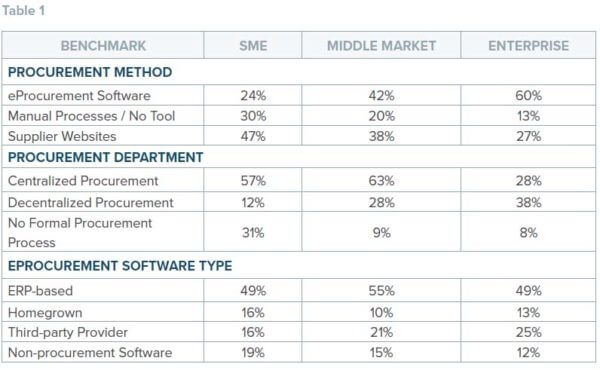 Another important element for procurement professionals to monitor is how procurement has changed over time. Following are a few notable trends in this year’s survey data.
Another important element for procurement professionals to monitor is how procurement has changed over time. Following are a few notable trends in this year’s survey data.
More departments indicated that they had multiple decentralized procurement departments in 2020 than they did in 2019. While this may seem to indicate organizations are shifting the management of procurement from one department to multiple departments, a closer look into the data shows that this increase is primarily driven by companies formalizing the procurement function and moving away from having no procurement department at all. Similarly, many companies are also establishing a formalized set of policies and standards for purchasing business goods.
Levvel Research assumes that this is partly in reaction to the COVID-19 pandemic—as many organizations are disparate and working remotely, tracking and monitoring spend has become a greater priority, Most organizations also cited that COVID-19 had exasperated existing challenges and brought about new issues, For companies attempting to add more structure to their procurement in the face of a global pandemic, setting up multiple procurement departments may seem easier than setting up just one,
Some organizations choose to formalize procurement by using purchase orders (POs) that require approval for goods or services to be bought. Figures 1 and 2 shows that these organizations are using POs for most or all of their purchases and that they have developed a process for the POs to be routed to the appropriate party for approval.

Regardless of whether a team is co-located or disparate and managed by one centralized department or multiple offices, automation software can help build a more structured procurement function. In fact, data indicates that many organizations have accomplished the task of both formalizing procurement and automating. A 2019-2020 comparison of how companies place orders with suppliers shows a rise in the utilization of eProcurement software (see Figure 3). Companies are moving away from relying on fully manual methods—such as phone and mail—and electronic (but inadequate) methods, like supplier websites and email, in favor of a tool designed for business procurement.
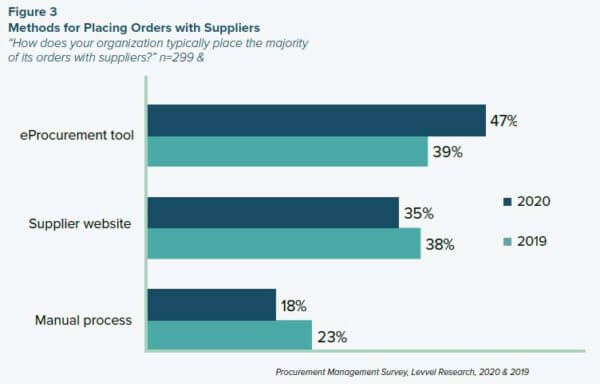
The increase in eProcurement adoption is a continuation of the rising adoption trend from 2018- 2019, but its growth in 2020 may have been further sparked by the pandemic. In fact, 42% of respondents stated that COVID-19 had made automation more appealing (Figure 4).

Globalization may be another driver. Research showed that less than 20% of organizations have an entirely domestic supplier base (Figure 5), and this number has decreased from 2019 survey data by 6%. Scaling a procurement operation to accommodate a global supply chain often comes with a new set of issues, including different tax requirements (notably, value-added tax, known as VAT), business culture disparities, currency conversion, and technological differences (including invoicing formats). eProcurement tools—especially those that handle the entire Procure-to-Pay process—often include features to help manage a global supplier list.

Organizations’ technology goals and improvement initiatives also have an impact on procurement software adoption. Data reflects an urge for more automation, visibility and control over the supply chain, and greater security among the top priorities of procurement leaders (Figure 6). In addition, upgrading software is also a top priority, which is often reflective of shifts elsewhere in the company toward legacy modernization. Focuses on modernizing and leveraging emerging technologies (another commonly prioritized initiative) are also both in line with broader digital transformation projects that improve a company’s ability to respond to market changes, both
in terms of stability and in product delivery. Whereas in previous years organizations have not typically applied the same digital strategies on cost centers as to profit centers, Levvel
Research is increasingly seeing a digital transformation mindset infiltrate back-office teams. More information on legacy modernization is available in 2020 Legacy Modernization Insight report.
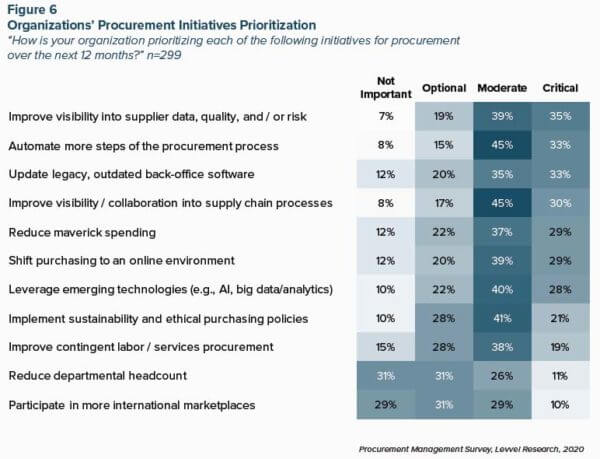 Challenges
ChallengesProcurement challenges stem from the fact that departments are maintaining antiquated, manual methods, as well as when these poorly designed processes don’t change as the organization scales or adopts technology elsewhere in the business. Figure 7 reveals the top four organizational challenges: data inaccuracies; poor communication between procurement and Accounts Payable (AP); inconsistent procurement processes; and unclear or lengthy processes.
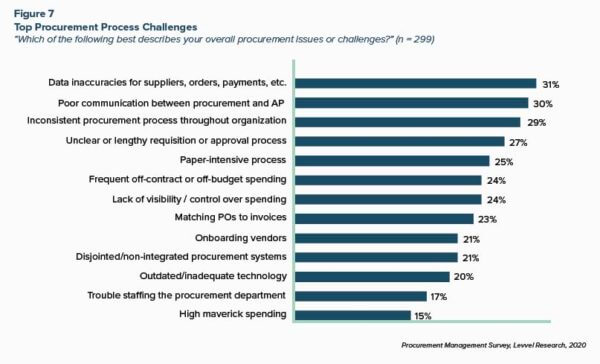
When asked for more detail on their challenges, responses revealed issues related to the COVID-19 pandemic. For instance, respondents mentioned difficulty in training employees on new software due to many employees working remotely. Many respondents indicated that COVID-19 made communication between AP and procurement worse. Others noted that using different solutions across various locations and departments made managing procurement difficult. One respondent—who works at a large manufacturing company that uses multiple ERPs and various procurement plug-in tools for those ERPs—said that the organization needed “one integrated solution that creates transparency and helps with requesting and approving, as well as budgeting for all departments.”
Many of the challenges associated with an outdated procurement tool or process can be remedied by implementing a modern, cloud-based eProcurement tool. Figure 8 shows that the most common benefits of automation include reduced errors, reduced paper volume, improved control/security, and better procurement visibility and transparency. Likewise, there are also many residual enhancements of automation, such as improved inventory management, better relationships with suppliers, and increased departmental productivity. One in three respondents reported that an eProcurement tool improved their organization’s ability to manage procurement remotely, which is a particularly important advantage under the current circumstances.
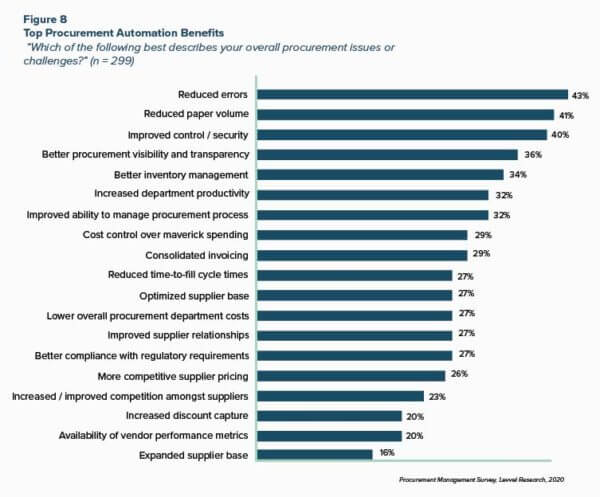
There are also a variety of reasons that companies choose not to automate their procurement with a modern tool. Figure 9 shows that the top hurdles to implementation include: the belief that the current processes function well just as they are; a lack of understanding regarding potential solutions; limited budgetary resources; inadequate technical resources to manage a tool; or a belief that implementation/training will distract from business as usual and take too much time.
In particular, verbatim responses revealed that some decision-makers fear the financial repercussions of implementation and subsequent reprimand from leadership; others believe that their organization’s process is too unique or complicated to be addressed by a standard tool. But, the most frequently cited barriers all have a common thread: They all suggest that procurement professionals are insufficiently educated on eProcurement software. Fortunately, many of these barriers could be addressed by researching how procurement software works, learning about the implementation process, and speaking to providers themselves. In particular, Levvel Research recommends communicating with potential automation providers regarding specific concerns and taking note of how they address those issues.
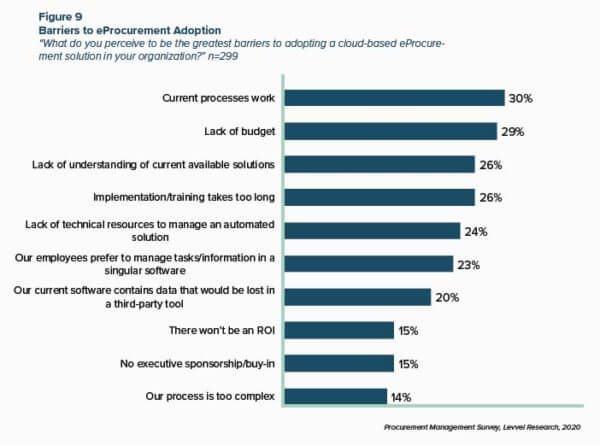
Procurement can be a hectic, time-consuming process if companies don’t regularly seek out ways to improve it and make it easier. One of the most significant steps an organization can take to strengthen its procurement function is to automate tasks that are low value-add, repetitive, and do not require significant analytical thinking. This influential transition is best begun by researching the different automation tools that are available. Figure 10 shows a breakdown of the current utilization of these types of tools, and Levvel Research segments these technologies into four categories:

Data shows that ERP-based tools are the most popular choice of today’s procurement departments. These are either simple add-ons to the out-of-the-box ERP or are included in the core features of the software. The appeal of ERP-based tools lies in the minimal investment of additional time and resources. Typically, the reasoning is that, because the ERP is already installed, these tools are a logical way to incorporate some of the major procurement tasks into an electronic environment. Additionally, because much of an organization’s most important financial information is stored in the ERP, there is no need to migrate data into another program. Plus, because employees are already trained in how to use the software, simple add-ons usually don’t require substantial implementation or training.
In reality, ERPs are not intended to automate procurement. Rather, their best usage is as a repository of financial, HR, and inventory/supply chain information. ERPs are great at general, high-level tasks, but they’re ill-equipped to handle the nuances and specific operations of the procurement process. Consequently, it comes as no surprise that respondents who use their ERP as their primary procurement tool express frustration in having to manage the process across multiple ERP instances. Most often, they’re able to more easily automate procurement with a third-party tool; in fact, one respondent said, “The consolidated functions of dedicated eProcurement software made sense for our business; we have seen a decrease in purchasing process time.” Another said that a new tool created a “… reduction in redundancy. We have three different systems, none of which allowed automated data upload or download to the other, so we found ourselves manually entering information multiple times throughout the week, which was a total waste of time and money.”
One of the main frustrations in using ERP-based tools is that an ERP is not built to automate or centralize the procurement process, especially for both buyers and suppliers. One respondent using this tool listed this as one of their biggest challenges: “Although there are plug-ins built into our system, most of our vendors don’t have the system and, thus, the plug-ins are worthless; we still have to submit the POs and orders manually.”
Conversely, homegrown solutions are tools that are built from the ground up for an organization’s specific needs. Typically, companies build this type of tool when they believe that their procurement process differs significantly enough from most organizations that an out-of-the-box tool would not meet their requirements. Historically, homegrown tools are more popular in industries with highly specific needs, such as government, utilities, education, and healthcare.
Unfortunately, organizations that choose to build their own tools often fail to properly survey the market to take stock of what tools are available to them, or to recognize the improvements that vendors have made to accommodate to unique procurement environments. Levvel Research has seen an increase in the popularity of vendors offering pre-built packages designed for specific industries and sizes of companies. Some vendors even focus entirely on a singular industry or small group of industries.
While homegrown tools can be well-built, their biggest drawback is their inability to adapt to the changing needs of a maturing business. Building an effective tool requires close attention to the nuances of the business needs of the individual organization. But, what happens when those needs change? Building these tools certainly requires a significant commitment of financial and temporal resources, but companies often neglect to maintain that commitment in the upkeep of the software. As a result, respondents using homegrown tools are far more likely to express interest in switching their tools in the next year; they’re also more likely to report that the software fell short of their expectations compared to users of third-party tools. Specifically, users of homegrown tools described their software as “hard to use,” “not user-friendly, overly complicated for our needs,” and “not upgradable.” One respondent even bluntly said that their tool was “a homegrown mess with no automation.”
Software that’s not specifically designed for procurement includes a wide variety of different tools—ranging from simple spreadsheets to expense management software—forced to act as a system for approving purchases. And, while spreadsheets are essentially a manual way of handling procurement, well-built, cloud-based expense management tools can act as a bridge between a manual environment and eProcurement software. These are most often used by smaller organizations that don’t think their spend warrants an investment in a dedicated procurement automation software. However, Levvel Research has observed that a growing number of expense management providers have incorporated additional features to address some of the more approval-focused, budgetary functions of an eProcurement tool—although these tools, too, fall short of a true procurement software. While they do meet some of the needs of smaller organizations, organizations of all sizes are still unable to truly automate many of the steps of the procurement process.
Therefore, cloud-based, third-party eProcurement software is usually the best option for organizations looking for a modern, dynamic solution. These tools are upgraded frequently, can be customized to meet the unique needs of an organization, and are easily implemented to interact with an organization’s financial software—including the ERP, but also other back-office products, like AP automation, sourcing, and contracting software. One respondent that moved from an ERP plug-in to a cloud tool said, “The consolidated functions of dedicated eProcurement software made sense for our business” and that they have “… seen a decrease in purchasing process time.” They also stated that switching surpassed their expectations because “… efficiency has increased and calculated ROI has exceeded projections by a few basis points.” Clearly, cloud- based eProcurement software outperforms the other options because it is specifically designed to address the purchasing needs of today’s organizations that are operating in a multitude of industries, locations, and revenue segments.
One of electronic procurement’s biggest benefits is the ability to centralize all purchasing activity, documents, and processes in a singular location. This reduces the confusion around where an order is in the approval process, where a PO is located, and what information suppliers need to put on an invoice. This centralization creates new visibility into purchasing and transaction data, which raises departmental and organizational efficiency. Each of the basic features of an eProcurement tool is necessary to achieve these benefits. The main modules of eProcurement software are outlined below:
Definition and Capabilities: Purchase requisition creation and workflow tools enable organizations to control employee spend from the beginning. Users can search an online catalog for items, add them to a configurable requisition template, and send the completed requisition through a rule-based approval workflow. The template can incorporate controls linked to company policies, budgeting, and inventory data. These templates can be set up during implementation, but advanced solutions ensure that the end user is able to easily configure this on their own. Making this process as easy as possible should be a priority for vendors, as companies often change workflow as policies change, employees change positions, and new product types need to be procured. Built-in controls prevent rogue spending by flagging noncompliant purchases based on predetermined rules, such as price or vendor, before requisitions are routed to the appropriate approver. Requisition tools also enable users to access frequently purchased items, compare multiple products, and save favorite searches.
Advanced approval workflow tools can be configured according to spending category, dollar threshold, business need, geographic location, supplier category, and other custom parameters. The workflow functionality can include escalation procedures to ensure timely approval, out-of- office forwarding capability, and workload balancing for approvers.
Who Benefits: eProcurement tools are often pitched as beneficial to the back-office, but requisition management is proof that the benefits extend to the entire organization. Not having to remember who to direct PO’s to and company policies are examples of how eProcurement makes the job of every employee that purchases business goods easier.�
Importance: Requisition management is deemed by survey respondents as the most important core feature of an eProcurement tool. 84 percent of them ranked it as “important”. This is usually the primary feature of an eProcurement tool. If an organization is taking a step by step approach to implementation, this is the first feature added.
Definition and Capabilities: Electronic catalogs function as online marketplaces, giving users extensive details and competitive pricing on a variety of goods. Most eProcurement solutions include support for the following catalog types: hosted (static); punch-out (external); advanced (hybrid); and specialized.
Hosted catalogs usually operate directly within eProcurement software. They categorize items by supplier or item type, and require supplier registration and maintenance to ensure that product information, pricing, and shipping details are correct.
Punch-out catalogs are hosted and maintained by suppliers, are integrated with the user’s ERP software, and quickly transfer purchasing information to the supplier’s system. Advanced catalogs are hybrids that combine features of hosted and punch-out catalogs. Specialized catalogs are tailored to a specific industry’s needs (e.g., a catalog of laboratory products).
Many eProcurement systems provide interactive, user-friendly catalog shopping in order to compete with Amazon. They allow the creation of requisitions and POs from catalog selections, and offer more accuracy and compliance than manual requisitions because they are integrated with supplier contracts and/or maintained by suppliers.
Who Benefits: Like requisition management, catalogs are beneficial to everyone in the organization that makes purchases. These combine the ease of making purchases off-contract directly from suppliers websites, with the control and visibility of an electronic procurement tool. Catalogs are helpful for employees that make purchases frequently and ones that purchase items irregularly.
Importance: Catalog management and punchout catalogs were deemed as important by 65 and 58 percent of respondents, respectively. This may be due to the fact that there are still many organizations that have only partially automated their procurement process with a homegrown tool or ERP add on. These tools typically do not feature catalog functionality.
Definition and Capabilities: In a modern eProcurement tool, POs are automatically created from an approved requisition and transmitted to the supplier. This gives an organization visibility into the status of the order throughout its fulfillment and eases communication with the supplier. Solutions may allow users to batch multiple orders from a single supplier, or send orders to several different suppliers from a single requisition. Solutions may support blanket orders and partial shipment orders, update contract terms or POs as shipments arrive, and allow suppliers to send advanced shipment notices (ASNs) when an order is ready for delivery.
Who Benefits: This feature of a solution primarily benefits procurement department staff. It simplifies the management of documents and information.
Importance: This functionality is usually combined with requisition management, so it is deemed as highly important to procurement professionals.
Definition and Capabilities: This is the aspect of an eProcurement tool that consolidates supplier information. Advanced self-service supplier management tools and self-service portals enable suppliers to communicate with buyers. They allow suppliers to accept POs, send ASNs, check on the status of invoices and payments, and update their profile and payment information.
Some solutions also allow suppliers to manage catalogs; choose how they want to receive their POs; and submit legal, tax, and validation documents. Many supplier management tools allow suppliers to send queries about current transactions, and they often provide an online dispute management help desk. Supplier management and self- service tools strengthen relationships with buyers and provide insight into the value of each relationship.
Who Benefits: An organization’s vendors are the primary beneficiaries of a supplier management tool. This makes their job of sending and accepting purchasing documents and information much easier, which in turn makes the buying organization’s procurement department operate faster and more efficiently. Businesses should be willing to communicate to their suppliers when they are planning on adopting a tool so they have ample time to adjust to the new process if necessary.
It is important to keep in mind that suppliers may be forced to use other eProcurement tools, leading to “portal fatigue” or unwillingness to use additional software, so offering flexibility in document submission is pivotal.
Importance: The various aspects of supplier management feature are ranked average to slightly above average in terms of importance. The self-service portal for suppliers is ranked as the least important of these features, with about 70 percent of respondents deeming it important. Roughly 76 percent called the supplier network important, and 77 percent did the same for supplier information management/risk management. The self-service portal more than likely ranks lower than the other parts of the tool because it is used primarily by the suppliers, whereas the other two are used by the actual eProcurement solution buyer.
Definition and Capabilities: Once a shipment is received, users can confirm the delivery and create a goods receipt. The receipt is checked against the PO to ensure that the right items and quantities have been received. Some software suites support returns or enable users to withhold part of a payment.
After goods are received, many solutions automatically convert the PO into an invoice for the supplier.The system can then match the PO, goods receipt, and invoice for reconciliation, and may also match against contracts. Some systems include a summary report on the order that contains all related documents (requisition, PO, etc.) to ease reconciliation.
During reconciliation, procurement software can integrate with a client’s existing AP processing system or forward the invoice through its own AP module. eProcurement software facilitates collaboration with other departments, including budgeting, compliance, treasury, and inventory. An eProcurement solution’s AP module likely includes invoice approval, exception management, and connectivity to electronic payments.
Who Benefits: Receiving and reconciliation features primarily benefit employees at the staff level of procurement departments. It automates much of the low-value add tasks of their jobs, like PO matching, freeing them up to focus on more strategic functions, such as supplier negotiation.
Importance: Receiving and reconciliation management is seen as important to roughly 81 percent of respondents, meaning it is ranked only behind requisition management. This is one of the primary reasons organizations adopt eProcurement software, as it automates many of the manual, time-intensive parts of the procurement process.
Definition and Capabilities: As an organization works to improve purchasing decisions, it must consider costs, benefits, and vendor performance trends. A strong reporting function provides unique and valuable insights into various areas of the business. Analytical capabilities allow managers to examine expenses by type, department, and region, as well as to prevent rogue spending.
eProcurement reporting software often includes both out-of-the-box report templates and the ability to generate custom queries and reports. Some solutions offer benchmarking to industry standards. Advanced eProcurement solutions include configurable dashboards that allow users to see information on process times, budgets, and suppliers, including spending reports, POs, and active invoices for approval, in the form of graphs and analytics widgets and tables. They also offer internal benchmarking capabilities, drag-and-drop report building, and drill-down capabilities. The ability to analyze specific report details allows an organization to view a single set of data from multiple perspectives, which creates reports that are tailored for use by different operational areas.
Who Benefits: Reporting and analytics tools benefit users at all levels in an organization, but are particularly useful for administrators and decision-makers with more strategic tasks and goals. Reports summarize spend activity and help managers and the C-suite to identify spending trends, optimize spend policies, and improve efficiency. Reporting dashboards give visibility into potentially fraudulent activity, spend occurring out of company policy, employees who are delaying invoice approval workflows, and suppliers that frequently send duplicate or incorrect invoices. The insights generated by advanced reporting and analytics tools aid C-suite professionals in targeting trouble spots and provide a holistic overview of the organization’s cash flow.
Importance: Reporting is traditionally viewed as one of the most highly valued features of a back-office tool. Because administrators and decision makers are the ones using this feature most often and will use the information in it to make choices and determine the future of the organization, ensuring that a potential solution has a strong reporting feature is of paramount importance.
Every feature previously listed is strengthened and powered in some way by an emerging technology. The primary technologies used in eProcurement software are artificial intelligence (AI), machine learning (ML), robotic process automation (RPA), blockchain, and big data. Almost one in five respondents listed failure to incorporate this technology into their current
eProcurement tool as a reason they are likely to switch providers in the next year. A similar figure listed lack of advanced analytics capabilities as a reason for upgrading tools. The time for these technologies to be considered mainstream is now. Most eProcurement vendors have features that rely on this tech and they are not content adding them to check a box; AI, ML, and RPA truly power the core of most of their software. They are also constantly laying out roadmaps and thinking of ways to integrate more usage of this technology into their solutions.
AI is a machine/computer that is designed to mimic a human’s ability to think and utilize logic. ML is a subset of AI that improves on this process. ML is the ability of machines to learn patterns and habits to carry out and improve upon processes without explicit human instruction. Both are pivotal in a modern eProcurement tool, and are used in various ways including detecting errors and discrepancies, intelligently matching items across purchase documents, and learning habits to improve accuracy and minimize human intervention.
Big data refers to datasets that are too large and complex for humans to extract significant conclusions from. Big data analytics is the application of AI and ML algorithms to these datasets to analyze and detect trends. Reporting powered by this technology draws real- time, actionable insights and visualizations, and, with its widely sourced data, generates more accurate KPIs and benchmarking. This not only gives organizations a better look into their past performance, but can be used to predict future outcomes.
Blockchain has a myriad of uses within procurement. It can be used at all stages of procurement: at the beginning of the process in contracting to ensure that supplier contracts are not tampered with and to ensure reliability and legitimacy of goods, and at the end to provide verifiable, traceable purchasing documents. It’s defined as an expandable set of records that carry and store unique information regarding transactions and events. The “block” aspect refers to the singular action and the related information, while the “chain” is the public record system that links the actions together. Blockchain is appealing because no part of it can be altered or modified after the event takes place, making it a secure, reliable source of truth. It is still in the early adoption phase, but is used to increase the security of data and money transfers, facilitate connections among groups and individuals, and decrease latency in transfers between parties.
One of the biggest hurdles to implementing eProcurement is the price tag. Therefore, understanding how pricing works is just as important as knowing the various features that a tool offers. For instance, an organization usually licenses the software in an annual subscription fee that is contingent upon several factors, including which features the organization utilizes. In addition to the subscription fee, companies also typically pay a one-time implementation fee. This implementation charge is applied by providers up front and goes toward the cost of training staff on the software, as well as IT resources to assist with the technological migration. Some providers also charge an organization’s suppliers for the use of the software, as well as for miscellaneous items, such as additional user support, international capabilities, mobile accessibility, and integrations with other ERPs.
Then, using purchasing information from the ERP, vendors will usually lay out an estimate of the total cost of ownership during a five- or ten-year timeframe. The two most popular models are:
The first step—even before an organization seriously considers automating the procurement process—is to understand the current state. Overlooking this step neglects to recognize the fact that, without careful consideration and mapping of processes, many pre-automation problems will follow an organization into post-implementation. Specifically, many issues that plague departments are process- and structure-related issues, which automation cannot fix. With that in mind, below are some questions organizations should consider as they analyze their current state:
Organizations should identify their annual indirect spend, measure how much it has changed in the last five years, and determine whether this volume changes seasonally. It’s also helpful to break down this spend by location of suppliers and buyers; type of spend; and purchase priority. Additionally, taking purchase orders into account helps evaluate the organization’s level of standardization and spend on contract. This is also an important step in calculating ROI and judging which vendor’s pricing model best suits the organization.
This is one of the first questions an organization should ask. Moreover, how does an organization handle the procurement of items? Is it the same every time? Does it differ by location or job title? Here, again, it’s also important to consider purchase orders from this perspective. Some organizations only require POs for certain types of purchases, such as spend type, amount, or occupational seniority. If an organization does not have a formalized set of rules around procurement, attempting to add software into the mix may actually make the process more confusing and expensive than it was before.
If an organization requires purchase orders, it’s crucial to establish rules for routing these documents for approval. For example, POs can be routed to employees’ direct managers, category managers, and higher-ups based on various criteria. Equally important is documenting when and if purchases require more than one approver, which may help the organization identify inefficient or redundant approval patterns that could be restructured. Documenting all of these differences simplifies automation and allows software providers to work with organizations to take these nuances into account during implementation.
This requires the organization to separate their suppliers by type, such as relationship length, priority based on spend, geographic location, and so on. This is also a good opportunity to measure how quickly suppliers respond to requests and how often their documents create exceptions; during this time, companies can also get an idea of the supplier’s own technological competence. Likewise, if an organization has a high number or international suppliers, any potential automation partners should be made aware to ensure that currency and language conversion, as well as risk management/fraud features, are available.
If organizational procurement is decentralized—meaning that it’s handled by more than one individual office, location, or department—the company should prioritize tools that will accommodate this structure. Along the same lines, if the company plans to maintain this structure, it’s equally important to review how the process operates across different locations. In particular, the organization should standardize its processes across locations in order to maintain consistency, reduce exposure to fraud, and increase departmental visibility. However, if standardization is not an option, it’s critical that the organization works with the vendor to ensure that these inconsistencies will not be an issue once the software is implemented.
Other more general considerations include an organization’s characteristics, such as its industry, annual revenue, or growth activity and rate. The organization should also factor in any other automation tools it currently uses, as well as its ERP or accounting software that are currently in place. More information on performing broader current state assessments can be found in the 2020 Payables Insight Report.
With many employees currently working from home, it’s imperative to find a solution that is suitable for a disparate workforce. Prior to the pandemic, remote work was already a growing trend, and it will continue to be prioritized post-pandemic. As such, employees who travel for work should still have access to software, and ensuring that a tool is cloud-based—as opposed to on the premises—should be a top priority. Plus, remote-friendly solutions that are cloud-based are accessible via the web and, consequently, don’t need to be installed on a specific computer. Mobility is another consideration; many procurement tools have mobile applications that are accessible via smartphone, yet retain the functionality of desktop tools.
Another important aspect of remote-friendly solutions is the visibility and control they can return to document and approval workflows. For example, employees working from home can no longer walk over to a colleague’s desk to check on the status of a purchasing document. But, remote-friendly tools give them the ability not only to see where documents are in the approval process, but also to change the workflow structure as needed. Likewise, inventory management features are also important during a time like this when supply chains are being disrupted. In addition to added visibility, strong inventory management features also help keep costs down and strengthen budgeting into the future.
This can be a difficult task to accomplish. Many providers claim to offer the same functionality with the same level of ease, but demos are the key here. Organizations that ask a lot of questions during software demonstrations will find a solution that fits them best. Key questions to ask include:
These questions will reveal how much work goes into managing the tool; tools that are not easily scalable, not configurable by the end-user, or that rely on high levels of customization will require more attention. Conversely, the goal of an eProcurement tool is to free up teams to pursue more value-add tasks, not to create more work related to dealing with the software and ensuring that it functions the way it’s supposed to.
When implemented correctly, eProcurement software can be a key component of a digital transformation. A forward-looking and innovative company maps out its future vision of how back- office processes would look in an ideal world and relays that information to potential automation partners. Key technologies to look for include RPA, AI, ML, and big data analytics; pay close attention not only to whether potential solutions have these technologies, but also how they use them. Are they merely checking boxes and incorporating them in small ways, or is the solution rooted in and built around them? Additionally, what tasks are providers accomplishing with that technology? A tool that lacks innovation will not scale well with a company that is looking to complete its digital transformation initiatives; rather, it may fit the needs of the organization at the time, but it will eventually become outdated as the business evolves.
In the COVID-19 business world, reporting and analytics tools are more important than ever. Well-built features allow an examination of the financial performance of an organization and provide a vision of what the future could look like with predictive analytics, which is pivotal in the uncertainty created by the pandemic.
Interestingly, the way to reduce dependency on an ERP for procurement functions may be to find a tool that is closely linked to it. For instance, eProcurement tools typically have partnerships and relationships with specific ERPs; so, the first step is to find a tool that integrates with the organization’s current ERP. Next, gauge how closely integrated the software is with the ERP. Does it automatically push information from the tool to the ERP? How often? Is it instantaneous?
Notably, software providers have experience with various instances of ERP software. As a result, they have witnessed custom add-ons and features and know how well their tool addresses the replacement or complementary steps in the ERP. Therefore, walking automation partners through the current, pre-implementation procurement process is key to ensuring that organizational needs are met.
Data shows that ERP-based tools are the most popular choice of today’s procurement departments. These are either simple add-ons to the out-of-the-box ERP or are included in the core features of the software. The appeal of ERP-based tools lies in the minimal investment of additional time and resources. Typically, the reasoning is that, because the ERP is already installed, these tools are a logical way to incorporate some of the major procurement tasks into an electronic environment. Additionally, because much of an organization’s most important financial information is stored in the ERP, there is no need to migrate data into another program. Plus, because employees are already trained in how to use the software, simple add-ons usually don’t require substantial implementation or training.
In reality, ERPs are not intended to automate procurement. Rather, their best usage is as a repository of financial, HR, and inventory/supply chain information. ERPs are great at general, high-level tasks, but they’re ill-equipped to handle the nuances and specific operations of the procurement process. Consequently, it comes as no surprise that respondents who use their ERP as their primary procurement tool express frustration in having to manage the process across multiple ERP instances. Most often, they’re able to more easily automate procurement with a third-party tool; in fact, one respondent said, “The consolidated functions of dedicated eProcurement software made sense for our business; we have seen a decrease in purchasing process time.” Another said that a new tool created a “… reduction in redundancy. We have three different systems, none of which allowed automated data upload or download to the other, so we found ourselves manually entering information multiple times throughout the week, which was a total waste of time and money.”
One of the main frustrations in using ERP-based tools is that an ERP is not built to automate or centralize the procurement process, especially for both buyers and suppliers. One respondent using this tool listed this as one of their biggest challenges: “Although there are plug-ins built into our system, most of our vendors don’t have the system and, thus, the plug-ins are worthless; we still have to submit the POs and orders manually.”
Conversely, homegrown solutions are tools that are built from the ground up for an organization’s specific needs. Typically, companies build this type of tool when they believe that their procurement process differs significantly enough from most organizations that an out-of-the-box tool would not meet their requirements. Historically, homegrown tools are more popular in industries with highly specific needs, such as government, utilities, education, and healthcare.
Unfortunately, organizations that choose to build their own tools often fail to properly survey the market to take stock of what tools are available to them, or to recognize the improvements that vendors have made to accomodate to unique procurement environments. Levvel Research has seen an increase in the popularity of vendors offering pre-built packages designed for specific industries and sizes of companies. Some vendors even focus entirely on a singular industry or small group of industries.
While homegrown tools can be well-built, their biggest drawback is their inability to adapt to the changing needs of a maturing business. Building an effective tool requires close attention to the nuances of the business needs of the individual organization. But, what happens when those needs change? Building these tools certainly requires a significant commitment of financial and temporal resources, but companies often neglect to maintain that commitment in the upkeep of the software. As a result, respondents using homegrown tools are far more likely to express interest in switching their tools in the next year; they’re also more likely to report that the software fell short of their expectations compared to users of third-party tools. Specifically, users of homegrown tools described their software as “hard to use,” “not user-friendly, overly complicated for our needs,” and “not upgradable.” One respondent even bluntly said that their tool was “a homegrown mess with no automation.”
Software that’s not specifically designed for procurement includes a wide variety of different tools—ranging from simple spreadsheets to expense management software—forced to act as a system for approving purchases. And, while spreadsheets are essentially a manual way of handling procurement, well-built, cloud-based expense management tools can act as a bridge between a manual environment and eProcurement software. These are most often used by smaller organizations that don’t think their spend warrants an investment in a dedicated procurement automation software. However, Levvel Research has observed that a growing number of expense management providers have incorporated additional features to address some of the more approval-focused, budgetary functions of an eProcurement tool—although these tools, too, fall short of a true procurement software. While they do meet some of the needs of smaller organizations, organizations of all sizes are still unable to truly automate many of the steps of the procurement process.
Therefore, cloud-based, third-party eProcurement software is usually the best option for organizations looking for a modern, dynamic solution. These tools are upgraded frequently, can be customized to meet the unique needs of an organization, and are easily implemented to interact with an organization’s financial software—including the ERP, but also other back-office products, like AP automation, sourcing, and contracting software. One respondent that moved from an ERP plug-in to a cloud tool said, “The consolidated functions of dedicated eProcurement software made sense for our business” and that they have “… seen a decrease in purchasing process time.” They also stated that switching surpassed their expectations because “… efficiency has increased and calculated ROI has exceeded projections by a few basis points.” Clearly, cloud- based eProcurement software outperforms the other options because it is specifically designed to address the purchasing needs of today’s organizations that are operating in a multitude of industries, locations, and revenue segments.
This year has ushered in a new use case for procurement automation. COVID-19’s profound impact on procurement and other back-office processes has made technology critical to business success, perhaps now more than ever. Organizations that implement automation software are able to more easily adjust to the circumstances of the pandemic, while many organizations using dated, manual procurement methods have faced a swift loss of departmental visibility, elevated supply chain risk, and a process thrown into flux by remote work.
The companies that recognize this use case will embrace digital transformation strategies to empower and enable their spend management. By following best practices to establish a sound procurement process, adopting software that truly automates tasks, and taking advantage of new technologies to further digitally transform the back office, organizations can stay proactive, and ready for future uncertainty.
You’re going to use technology to change the world. We’re going to help you create it. Whether you are reinventing your company, creating an industry-changing product, or making existing products even better with new technologies—we exist to make your endeavor a success story.
Our experts help unleash your engineering team’s potential. You know that you need to transform your software development lifecycle, and you need to move quickly. We bring seasoned experts to work with you to not only get the processes and tooling right, but to win with the human element of this critical transformation.
Major Bottoms Jr is a Research Consultant for Levvel Research based in Charlotte, NC. He plays a key role in the analysis and presentation of data for Levvel’s research reports, webinars, and consulting engagements. Major’s expertise lies in the Procure-to-Pay, Source-to-Settle, and travel and expense management processes and software, as well as technologies and strategies across DevOps, digital payments, design systems, and application development.
Anna Barnett is a Research Senior Manager for Levvel Research. She manages Levvel’s team of analysts and all research content delivery, and helps lead research development strategy for the firm’s many technology focus areas. Anna has extensive experience conducting and writing market research on a variety of business and technology areas.
PairSoft develops, sells, and supports advanced web-based and mobile requisition, procurement, accounts payable, and expense solutions for mid-market and enterprise organizations across a range of industries worldwide. PairSoft Payments provides enterprise users with the option of adding automated ACH payments within the PairSoft Spend Management solution for a fully centralized standalone P2P platform. The user interface offers flexible P2P automation and robust expense reporting that is easy for employees, effective for management, and powerful for accounting.
